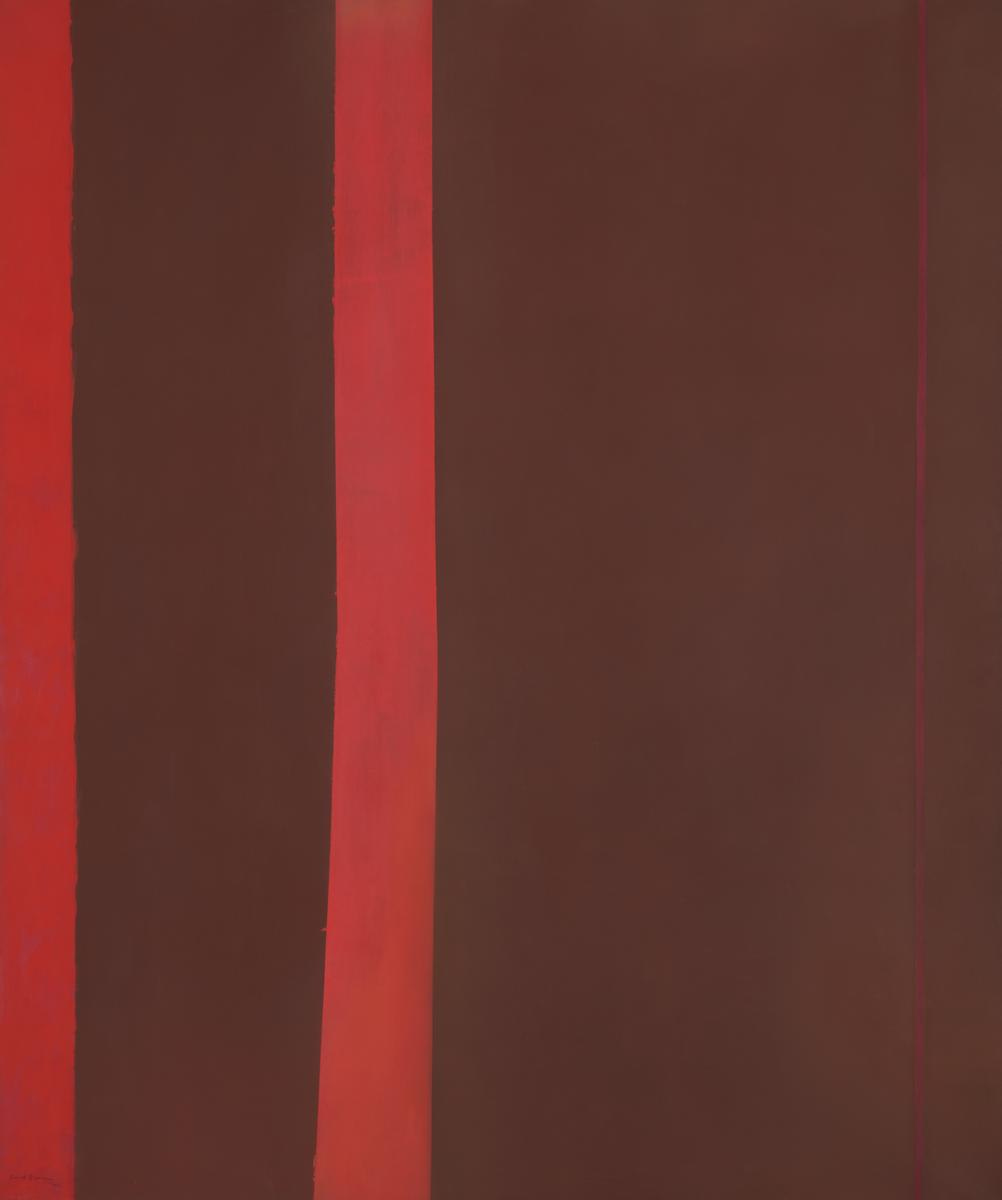Totality (5)
An Asynchronous Studio Book Club reading of Totality: Abstraction and Meaning in the Art of Barnett Newman by Michael Schreyach.

Well, that was a wild ride. While repeating some of the themes of the previous chapter, Schreyach devoted this one, “Standpoint,” to an extended meditation on Adam (1951-52). Moreover, it made a case for the figurative aspect of Newman’s art.
It begins with a discussion of the bending third stripe that Newman added just left of center a year after the completion of the rest of the painting. Page 164:
It must have been the case that, with its erect column, Newman (eventually) found his painting to harbor an expression of the theological Adam’s existence, or being, or agency. Said somewhat differently, Adam’s content involves the implications of the biblical Adam having been created and, ostensibly, as having been the first man. For Newman, such an understanding would have resulted not simply from an exegetical project (a matter of his interpreting from the book of Genesis what God had done or meant to do in creating Adam and Eve), but rather from a self-reflective one (a matter of Newman trying to understand from his own painting what he had done or meant to do in making Adam). It would not have been lost on the habitual wordsmith that his double reflection on Adam as the “first man,” and on himself as the “New-man,” could be at once broadly metaphysical and specifically pictorial.
Along the way, Schreyach reverts the title of a work now known as “untitled” to its original, Adam #2, and declares (page 178):
I suggest that Adam and Adam #2 recapitulate the typological doubling of Adam and Christ.
And then (page 179):
But now I would like to suggest that Newman implicitly addressed the conundrum through what we might call a displacement of the “iconography” of the human figure to an adjunct medium: namely self-portrait photography. In doing so, he laid the groundwork for an approach to the putative absence of the human figure from Adam, and from his works more generally.
Finally, regarding the silhouette of the artist’s profile on the corner of Eve (1950, also in the Tate Modern) in the photograph by William Vandivert (page 182):
In other words, there is a “skull” at the base of the painting. In light of my discussion of Vir Heroicus Sublimis, a speculative claim emerges: Vandivert’s photograph harbors something like the iconography of Adamic typology [the skull of Adam at the base of the cross upon which Jesus is crucified, as per apocrypha—F.], and it is possible that Newman and his portraitist consciously set out to replicate such a visual trope. If the claim strains credulity…
…perhaps a more general one can be advanced: eliminated from Newman’s resolutely abstract paintings, explicit references to the human figure have, in this photograph and others, reappeared as shadows projected upon the surfaces of works.
Robert Hughes, in 1990, after a decade that “may be officially dead, but it won’t lie down yet,” recalled:
Thirty years ago Abstract Expressionism was pretty well a mandatory world style. In Australia we looked at it with awe. The bottle in which its messages washed up on our shore (the paintings themselves did not cross the Pacific) was the magazine ARTnews. Its hagiographic tone was clear. Except for the titans of the history books, from Michelangelo and Leonardo down to Picasso and Matisse, whose work we hadn’t seen either, we had never read the kinds of claims made for any artist that Harold Rosenberg or Thomas Hess made for figures such as Barnett Newman and Willem de Kooning. They were grand enough to stifle aesthetic dissent. Only contact with the originals could have tested them, and we could not see the originals. Thus, although we did not know it, we were in the situation of many American artists outside New York in 1960—flat on our backs, waiting for the missionary.
I’m hardly accusing Schreyach of that kind of imperialism, and if anything, serious art-making of Newman’s kind needs missionaries, though not in the sense of Hughes’s image. But Hughes’s criticism was important to me as a younger writer,1 and I appreciate his elucidation of the Cultural Cringe in new light upon reading this chapter of Totality. We’re now nigh 200 pages into one of the most erudite considerations of Newman’s work ever produced. Nevertheless I find myself in recent times endeavoring to explain abstract art to the uninitiated and unsympathetic, such as Bryan Caplan. Caplan and Schreyach are roughly the same age and both university professors, and yet the gulf between them on this topic might as well be the Mariana Trench. Geometric abstraction in Western easel painting is a century-and-a-quarter-year-old tradition. Shouldn’t it be as accepted as impressionism by now? And yet it’s not.
I’m planning out some busy weeks in the studio. While I’ve had more specific thoughts about the content of this chapter, the thought pressing on me the hardest is that I would like to paint a body of work that merits this kind of scrutiny and contemplation. I kind of don’t care whether Schreyach is on firm ground connecting anything Newman painted to that fateful event at Golgotha. I just want to make something that would yield treasure if someone considered it as deeply as Schreyach is looking into Newman. Even if no one ever does.
Content at DMJ is free but paid subscriptions keep it coming. Please consider one for yourself and thank you for reading.
We are in the midst of an Asynchronous Studio Book Club reading of Totality: Abstraction and Meaning in the Art of Barnett Newman by Michael Schreyach. Obtain your copy and jump in. For future titles, see the ASBC schedule.
Dissident Muse’s first publication, Backseat Driver by James Croak, is available now at Amazon.
Aphorisms for Artists: 100 Ways Toward Better Art by Walter Darby Bannard is out now at Allworth Press. More information is available at the site for the book. If you own it already, thank you; please consider reviewing the book at Amazon or B&N.
“Requiem for a Featherweight,” Hughes’s posthumous bludgeoning of Jean-Michel Basquiat, was an inspiration. Murray Kempton once wrote that a critic is someone who enters the field of battle after the war is over and shoots the wounded. Hughes entered the field and shot the dead.


